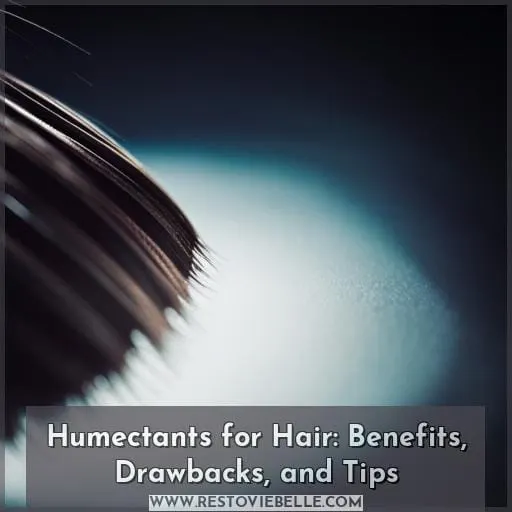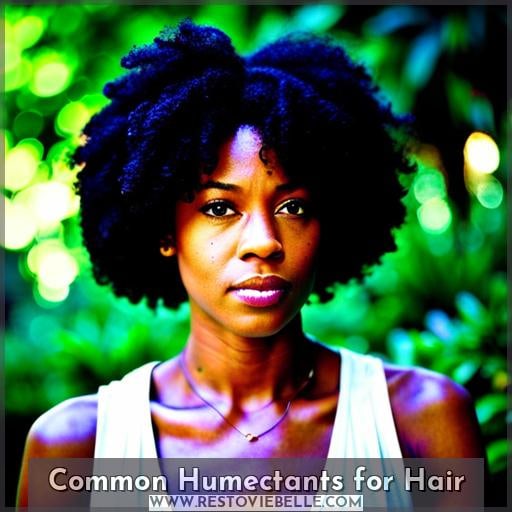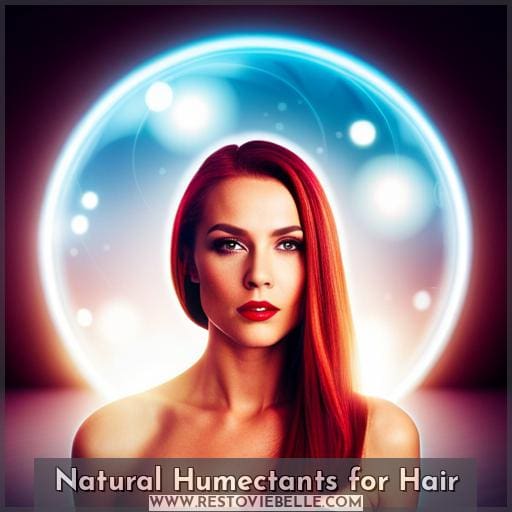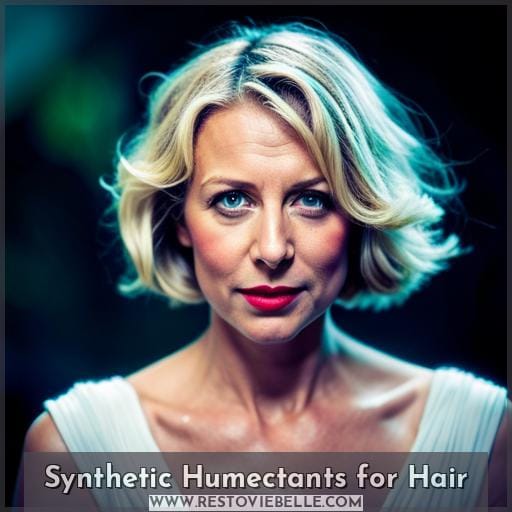This site is supported by our readers. We may earn a commission, at no cost to you, if you purchase through links.
 Are you looking for ways to keep your hair moisturized and healthy? Humectants could be the answer. With one study finding that shampoo with humectants can improve hair hydration by up to 40%, these powerful ingredients are worth exploring.
Are you looking for ways to keep your hair moisturized and healthy? Humectants could be the answer. With one study finding that shampoo with humectants can improve hair hydration by up to 40%, these powerful ingredients are worth exploring.
Let’s take a closer look at how humectants work, their numerous benefits, potential drawbacks, and helpful tips on using them in your hair care routine.
Table Of Contents
- Key Takeaways
- Understanding Humectants
- How Do Humectants Work?
- The Benefits of Humectants for Hair
- The Potential Drawbacks of Humectants
- Common Humectants for Hair
- Natural Humectants for Hair
- Synthetic Humectants for Hair
- The Role of Emollients in Hair Care
- Humectants Vs. Anti-Humectants: Finding the Right Balance
- Tips for Using Humectants for Healthy, Hydrated Hair
- Conclusion
Key Takeaways
- Humectants enhance hair hydration by up to 40%.
- Anti-humectants repel moisture for hair protection.
- Emollients soften, protect, and condition hair.
- Natural alternatives like aloe vera and honey exist for hair hydration.
Understanding Humectants
You can take control of your hair’s moisture levels and safeguard against environmental impacts by understanding the role humectants play in providing lasting hydration.
Humectants are a type of hydrator that binds to water molecules, locking in moisture for textured hair and controlling frizz.
Hair porosity also plays an important role as it determines how well products penetrate the cuticle layer. Low-porosity types should be cautious when using humectant combinations due to their ability to draw more humidity into the strands than desired.
When used correctly, however, these powerful ingredients help balance out extreme conditions like high or low humidity while delivering effective hydration without overloading on moisture or drying out tresses.
Despite common misconceptions about these substances leading to dryness, they’re actually excellent solutions for maintaining healthy locks with proper care and protection from other damaging factors such as heat styling tools and harsh chemicals found in many haircare products today.
With appropriate preparation before application, such as pre-shampoo treatments with oils or butters, plus regular deep conditioning sessions afterwards, you will ensure optimal results every time!
How Do Humectants Work?
By understanding the molecular mechanisms of humectants, you can better equip yourself to use them for optimal hair health. Humectant molecules are polar, meaning they have a positive and negative charge that attracts water from the environment or other substances.
This is known as absorption and adsorption—when moisture binds to their molecules instead of penetrating it.
When used on curly hair, these agents help retain hydration by drawing in water vapor from the air humidity levels into your strands. However, too much moisture will lead to frizziness due to swelling or stickiness due to clumping of curls together.
To combat this issue, anti-humectant products are available which prevent excessive absorption while still allowing some level of protection against dryness caused by low dew points, especially during cold weathers when our scalp’s sebum production slows down, leading to further breakage in curl texture without proper nourishment and moisturizing techniques.
Using natural emollients such as coconut oil or castor oil combined with key ingredients like glycerin, aloe vera extract, provitamin B5, caprylic capric triglycerides, etc.
The Benefits of Humectants for Hair
Discover the amazing benefits of moisture-binding agents on your hair health and how they can enhance suppleness, bounce, and curl retention. Humectants have a powerful hydration power that helps to retain moisture in your curls.
This aids in creating a healthy balance of oils and water, which is essential for smoothness, shine, elasticity, and minimizing frizziness.
Not only do humectants help maintain curl definition, but they also provide better styling options by controlling humidity levels. This ensures that you don’t end up with limp or flyaway strands! By providing extra nourishment to the scalp through their natural ingredients such as glycerin, aloe vera gel, or provitamin B5, humectants give thirsty hair an added boost of hydration it needs without causing damage over time like some chemical products might do.
They create softness while keeping curls bouncy all day long – perfect for those days when you want your hair looking its best! Curly-haired beauties who are worried about dry air conditions should consider using anti-humectant products alongside regular moisturizers.
This will prevent excess absorption from occurring while still allowing hydrating effects from both items together.
Humectants are suitable for any type of tresses, whether straight or curly. So there’s no need to worry if you don’t fit into one category – these types of products will be beneficial regardless! With careful selection, even curly girls can get more mileage out of their favorite styles when used correctly along with other hair care elements like emollients & sealers/occlusives as part of an effective moisturizing system tailored just for them.
The Potential Drawbacks of Humectants
Despite the many positive impacts of humectants, it’s important to be aware of their potential drawbacks as well. Humidity can bring out the worst in them. Frizz, swelling, and stickiness are all possible effects when high humidity levels combine with hydrogen bonds formed by biological humectants.
Conversely, low humidity conditions can result in dryness and damage risks due to moisture imbalance. Moreover, proper hair care may require a combination of products. Not using an anti-humectant or sealant could lead to additional frizz factors from excess moisture absorption.
It’s also essential for healthy hair tips that people recognize universal applicability doesn’t mean ideal results across all types and textures. Curly locks often need extra attention since sebum production does not reach the ends quickly enough on its own.
Following these steps will help ensure an effective moisturizing system suitable for different environmental conditions while avoiding potentially harmful consequences caused by improper use of humectants, such as permanent damage from excessive drying alcohols present within some products found off store shelves.
Common Humectants for Hair
Unlock the secret of luscious curls with common humectants like glycerin, aloe vera, and panthenol! Humectants are powerful moisture-binding agents that can help you achieve healthy, hydrated hair. Certain humectant properties, such as polarity and hydrogen bonding, allow them to absorb water molecules from the air.
This creates a protective barrier against environmental damage while providing beneficial properties like softening and elasticity.
Popular ingredients often used in hair products include sodium PCA, glycerin, urea, and hyaluronic acid, all of which have great moisturizing benefits. However, there are some drawbacks to using humectants. Over-application or exposure to high/low humidity conditions can lead to potential frizziness or dryness.
To maximize their effectiveness, you can use anti-humectants depending on your environment’s dew point levels for optimal curl retention.
In addition to choosing the right products, application techniques also play an important role in allowing the product to effectively penetrate into your cuticles for maximum benefit. Consider using a leave-in conditioner applied after shampooing, followed by a serum for extra protection as part of your daily routine.
Natural Humectants for Hair
Humectants are powerful moisture-binding agents that can be found in many hair care products. They attract water molecules from their environment, helping to keep hair hydrated and healthy.
Natural humectant alternatives offer DIY recipes and environmental impact solutions without compromising on performance or style retention. For those who want an all-natural approach to humidity control, there are a number of natural humectant ingredients available with polarity levels close enough to mimic the action of common synthetic ones like propylene glycol and sorbitol.
These include aloe vera juice, honey extracts, apple cider vinegar, as well as vegetable glycerin. Vegetable glycerin has been used for centuries in cosmetic formulations due to its excellent hydrating properties.
When it comes to styling with natural humectants versus traditional heavy gels or creams, you just need one simple rule – less is more! The key lies in finding a balance between using too much product, which could leave your scalp feeling weighed down, but also applying enough so that you still achieve definition without frizzing out when exposed to heat/humidity or other outside elements.
Also, use proper tools such as diffusers, combs, brushes, etc., to ensure optimum results! Finally, this combination should provide optimal curl shapes along with lasting shine, luster, and necessary protection against any damage caused by external factors like the sun, wind, pollution, sweat, etc.
Synthetic Humectants for Hair
You can also take advantage of synthetic humectants to help lock in moisture and keep your curls looking their best—it’s like putting a lid on the jar. Synthetic humectants offer many benefits, such as providing lightweight moisturizing without dulling or weighing down the hair.
They have an added ability to seal in moisture for long-lasting hydration, making them ideal for curly hair types that need extra protection against humidity and dryness.
However, there is potential risk when using certain synthetic humectants due to harsh ingredients that could cause damage if not used correctly within a haircare routine.
When it comes to natural vs synthetic humectant use, there are pros and cons with both options depending on which type best suits individual needs. Some may prefer more natural products while others opt for synthetics because they don’t contain any animal byproducts or allergens like gluten or soy proteins found in some organic brands.
Popular synthetic ingredients include propylene glycol (PG), butylene glycol (BG), and silicone copolyols. These all work together synergistically when incorporated into haircare formulas specifically designed with curly girl method principles in mind.
The Role of Emollients in Hair Care
Understanding the role of emollients in hair care is key to maintaining healthy curls. Emollients are non-greasy oils and fats that help condition, soften, and protect the hair from environmental damage.
Improved elasticity is one of the benefits of emollients. They provide a boost to dry or damaged strands by adding hydrophobic fatty acids, which strengthens strands against breakage while also promoting flexibility.
Emollients also contribute to hair softness. These agents fill gaps in the cuticle layer, resulting in a softer texture with less frizz.
Shine enhancement is another advantage of emollients. Natural emollient ingredients like coconut oil can be used as an alternative styling agent to add shine without weighing down your curls.
Emollients differ from humectants since they do not draw moisture out of their environment. Instead, they create a protective barrier around each individual strand that helps retain existing moisture levels within its structure.
Hyaluronic acid and panthenol are examples of excellent natural ingredients commonly found in many different types of curly hair products due to their incredibly hydrating properties. On the other hand, more oily substances like jojoba oil offer increased protection against heat styling tools when applied correctly prior to usage.
Ultimately, keeping these powerful conditioning agents properly incorporated into your regular routine will ensure consistent results for healthier-looking locks over time!
Humectants Vs. Anti-Humectants: Finding the Right Balance
Knowing the balance between humectants and anti-humectants is like mastering a dance: it takes practice to get the steps just right.
Humectants are molecules that attract moisture from their environment, while anti-humectants repel it. Using these two elements in combination can help prevent frizz and regulate moisture for various hair types.
Alpha Hydroxy Acids (AHAs) are common humectant ingredients found in many hair products, as they provide deep hydration without weighing down your curls or making them greasy. Sodium Lactate is another frequent choice of ingredient used as an antifrizz solution; its low pH helps maintain healthy cuticles which aids with weather protection and bounce retention.
| Humectants | Anti-Humectants | Usage |
|---|---|---|
| Propylene Glycol | Shea Butter | Moisturizing Hair |
| Hydrogenated Castor Oil | Protecting Curls From Weather Damage | |
| Mango Butter | Prevent Frizz & Flyaways | |
| Glycerin |
Tips for Using Humectants for Healthy, Hydrated Hair
Making the most of your natural hair’s curl potential requires finding a healthy balance between humectants and anti-humectants.
- Humectant Application: It’s important to know which areas need more or less moisture. Applying too much in dry areas can lead to side effects like dry skin, while not enough could leave your curls limp and lifeless.
- Humectant Dosage: Start with small amounts that gradually increase over time according to how curly hair responds to it. Use as little as possible for maximum benefit without any negative impact on the scalp or strands.
- Humectant Storage: Properly store products containing humectants away from direct sunlight or high temperatures since they can lose their effectiveness quickly when exposed.
- Humectant Compatibility: Different types of humectants have different levels of compatibility with other ingredients found in styling products, so make sure yours is suitable before use. Also check if there are any side effects associated with combining certain ingredients together for safe application every single time.
By following these steps carefully, you’ll be able to retain moisture better while avoiding common pitfalls associated with misusing humectants such as frizziness and breakage due to incorrect dew point management techniques used during product selection phases.
By understanding its properties thoroughly combined with knowing exactly what type works best for your unique curl pattern, you’ll be able to maximize its benefits effectively over long periods whether environmental conditions change drastically.
Conclusion
It’s clear that humectants are a powerful tool for maintaining healthy, hydrated hair. They provide suppleness and elasticity, as well as improve curl retention. These moisture-binding agents can go a long way towards helping you achieve your hair goals.
However, it’s important to understand the potential drawbacks of using humectants, such as frizz, dryness, and damage. By choosing the right combination of humectants, emollients, and anti-humectants, you can enjoy all the benefits of using humectants for hair without any of the negative side effects.
With the right knowledge and products, you can give your hair the care it needs to stay hydrated and healthy.














